Summary
How the assessment was made
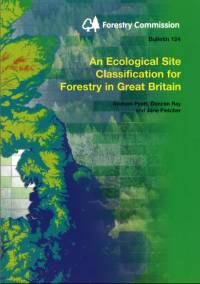 To assess the potential effect of dry summers on species suitability, information about the interactions between tree species, climate change, sites and soil properties is necessary at a detailed local level. National digital soil data from the Soil Survey of Scotland (SSS) published at a scale of 1:250 000 (Macaulay Institute) is not sufficiently detailed for assessing the impact of climate change on forest soils at a site-level.
To assess the potential effect of dry summers on species suitability, information about the interactions between tree species, climate change, sites and soil properties is necessary at a detailed local level. National digital soil data from the Soil Survey of Scotland (SSS) published at a scale of 1:250 000 (Macaulay Institute) is not sufficiently detailed for assessing the impact of climate change on forest soils at a site-level.
Considering that the main climate impacts on forests are likely to result from by drier summers and wetter winters, a primary source of climatic information are the moisture deficit (MD) maps for different UKCIP02 emissions scenarios.
Suitability analyses were made on the basis of changes only in the climatic data, under the assumption that if the climate becomes drier then soils become drier (and vice-versa). The method of coupling moisture deficit (MD) with soil moisture regime (SMR) is integral to the stand-based methodology of Ecological Site Classification (ESC), outlined in Forestry Commission (FC) Bulletin 124 – An Ecological Site Classification for Forestry in Great Britain (Pyatt, Ray, and Fletcher, 2001).
Impact of more frequent dry summers
It is perceived that the climate projections of more frequent dry summers in the east and south of Scotland will reduce the suitability of some species of tree. Dry summers combined with shallow freely draining soils may lead to widespread moisture stress for sensitive species. This may have implications for timber quality and contribute to the increased risk of outbreaks of disease from pests and pathogens. The photographs below show damage to Sitka spruce stems in eastern Scotland following the dry summer of 2003.
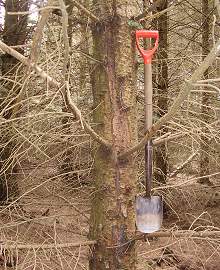
Longitudinal lesions on the stem of Sitka spruce, growing on shallow stony gleyed podzol, in Durris Forest, Aberdeenshire, following the dry summer of 2003.
(Photo: Bill Rayner, Forest Research)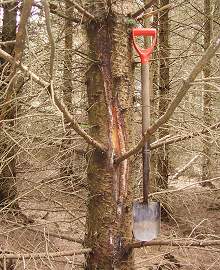
Crack exposed after removing bark lesion on Sitka spruce in Durris forest, Aberdeenshire.
(Photo: Bill Rayner, Forest Research)
Impact of wetter winters
On some types of soil, the projected wetter winters will increase winter water-logging, leading to anaerobic conditions – root respiration stress, and root death. On such sites trees will have shallower root plates, and this will intensify summer moisture stress. These issues are discussed in detail in the downloadable report below.
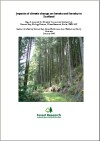 Impacts of climate change on forests in Scotland – final report (PDF-1225K)
Impacts of climate change on forests in Scotland – final report (PDF-1225K)
By Duncan Ray with sections drafted by Dave Wainhouse, Joan Webber and Barry Gardiner.
14th January 2008.
Suitable tree species on forest soils in eastern Scotland
To try and understand the interactions between climate, soil-site type and the impact on tree species suitability, a data- and knowledge-base is being developed for forest soils in the drier south-eastern area of Scotland. The map below shows the region of eastern Scotland considered to be at most risk of drought in the current climate, and at increasing risk of drought in projected future climate scenarios. The map is based on the Met. Office Regional Evaporation Calculation System (MORECS), 40 km squares. Both the MORECS data and the UKCIP02 climate change simulations show a higher risk of drought (2 summer months without rain) in the area bounded by these squares.
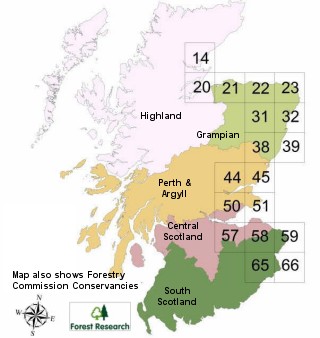
Met Office Rainfall and Evaporation Calculation System (MORECS) 40 km grid squares in eastern and southern Scotland in which there is an increased risk of summer drought.
The table below provides some information about the main forest soils in each of the MORECS squares (shown numbered in the map above) in which dry summers can increase the risk of drought. For each 40x40km square, attributes of the main forest soils described by the Soil Survey of Scotland (SSS) and the Forestry Commission (FC) Soil Classifications, have been examined to assess the droughtiness of the given soil type within the square. From knowledge of the soil type and drought risk, a list of tree species and native woodland types are recommended as suited to drier summers on each specific soil type.
| MORECS Square No. | Percent area of forest | Dominant forest soil series (top 3) described by the SSS | Equivalent FC soil type(s) and phase(s) associated with SSS soil series | Drought risk | Species and native woodland options for climate change adaptation on the soil type | |
|---|---|---|---|---|---|---|
| Suitable productive species | Suitable woodland communities | |||||
| 14 | 23 | Sabhail | 4px | Medium | Scots pine, lodgepole pine, downy birch | Downy birch with purple moor grass, native pinewood, willow scrub |
| Ramscraigs | 4bx(g) | Medium | Scots pine, lodgepole pine | Downy birch with purple moor grass, upland birch/oak woodland, native pinewood, juniper woodland | ||
| Blanket peat | 9, 10, 11, 14 | Low | Mixture lodgepole pine and Sitka spruce on soil type 9. No suitable woodland for soil type 10 | Wet woodland – downy birch with purple moor grass, fen carr, and willow scrub on flushes. No suitable woodland for soil type 10 | ||
| 20 | 41 | Millbuie | 3xg | Medium | Scots pine, lodgepole pine, Corsican pine | Upland birch/oak woodland, native pinewood, juniper woodland |
| Kindeace | 3xg | Medium | Scots pine, lodgepole pine, Corsican pine | Upland birch/oak woodland, native pinewood, juniper woodland | ||
| Corby | 3xs | High | Scots pine, lodgepole pine | Upland birch/oak woodland, native pinewood, juniper woodland | ||
| 21 | 38 | Basin peat | 8, 10 | Low | Sitka spruce, lodgepole pine. No suitable woodland for soil type 10 | Alder wet woodland on soil type 8. No suitable woodland for soil type 10 |
| Strichen | 3x | High | Scots pine, lodgepole pine | Upland birch/oak woodland, native pinewood, juniper woodland | ||
| Corby | 3xs | High | Scots pine, lodgepole pine | Upland birch/oak woodland, native pinewood, juniper woodland | ||
| 22 | 17 | Durnhill | 4zpx | Medium | Scots pine, lodgepole pine | Downy birch with purple moor grass, native pinewood |
| Strichen | 3x | High | Scots pine, lodgepole pine | Upland birch/oak woodland, native pinewood, juniper woodland | ||
| Blanket peat | 9, 10, 11, 14 | Low | Mixture of lodgepole pine and Sitka spruce on soil type 9. No suitable woodland for soil type 10 | Wet woodland – downy birch with purple moor grass, fen carr and willow scrub on flushes. No suitable woodland for soil type 10 | ||
| 23 | 7 | Strichen | 3x | High | Scots pine, lodgepole pine | Upland birch/oak woodland, native pinewood, juniper woodland |
| Thurso | 7 | Low | Sitka spruce, Norway spruce, silver birch, common alder, pedunculate oak, sycamore, ash | Ash, oak or mixed broadleaved woodland | ||
| Blanket peat | 9, 10, 11, 14 | Low | Mixture of lodgepole pine and Sitka spruce on soil type 9. No suitable woodland for soil type 10 | Wet woodland – downy birch with purple moor grass, fen carr, and willow scrub on flushes. No suitable woodland for soil type 10 | ||
| 31 | 22 | Countesswells | 3x | High | Scots pine, lodgepole pine | Upland birch/oak woodland, native pinewood, juniper woodland |
| Foudland | 3 | Medium | European larch, Scots pine, sessile oak, silver birch, sycamore | Upland oak woodland | ||
| Charr | 4zpx | Medium | Scots pine, lodgepole pine | Upland birch/oak woodland, native pinewood | ||
| 32 | 8 | Countesswells | 3x | High | Scots pine, lodgepole pine | Upland birch/oak woodland, native pinewood, juniper woodland |
| Tarves | 1 | Medium | European larch, Scots pine, sessile oak, silver birch, sycamore, Douglas fir | Oak and birch woodland | ||
| Corby | 3xs | High | Scots pine, lodgepole pine | Upland birch/oak woodland, native pinewood, juniper woodland | ||
| 38 | 22 | Countesswells | 3x | High | Scots pine, lodgepole pine | Upland birch/oak woodland, native pinewood, juniper woodland |
| Tarves | 1 | Medium | European larch, Scots pine, sessile oak, silver birch, sycamore, Douglas fir | Oak and birch woodland | ||
| Charr | 4zpx | Medium | Scots pine, lodgepole pine | Downy birch with purple moor grass, native pinewood | ||
| 39 | 22 | Countesswells | 3x | High | Scots pine, lodgepole pine | Upland birch/oak woodland, native pinewood, juniper woodland |
| Strichen | 3x | High | Scots pine, lodgepole pine | Upland birch/oak woodland, native pinewood, juniper woodland | ||
| Dess | 3xg | Medium | Scots pine, lodgepole pine | Upland birch/oak woodland, native pinewood, juniper woodland | ||
| 44 | 17 | Strichen | 3x | High | Scots pine, lodgepole pine | Upland birch/oak woodland, native pinewood, juniper woodland |
| Balrownie | 1g | Low | European larch, Scots pine, sessile oak, silver birch, sycamore, Douglas fir | Oak and mixed broadleaved woodland | ||
| Sourhope | 1d | Medium | Sessile oak, silver birch, sycamore, Douglas fir, European larch | Oak and birch woodland | ||
| 45 | 10 | Balrownie | 1g | Low | European larch, Scots pine, sessile oak, silver birch, sycamore, Douglas fir | Oak and mixed broadleaved woodland |
| Forfar | 3g | Low | Scots pine, European larch, Corsican pine, pedunculate oak, sycamore | Upland birch/oak woodland, native pinewood, juniper woodland | ||
| Lour | 7 | Low | Sitka spruce, Norway spruce, silver birch, common alder, pedunculate oak, sycamore, ash | Ash, oak or mixed broadleaved woodland | ||
| 50 | 14 | Sourhope | 1d | High | Sessile oak, silver birch, sycamore, Douglas fir, European larch | Oak and birch woodland |
| Winton | 7b | Low | Sessile oak, downy birch, beech, sycamore, European larch, Corsican pine, Scots pine, Sitka spruce | Oak woodland | ||
| Basin peat | 8, 10 | Low | Sitka spruce, lodgepole pine. No suitable woodland for soil type 10 | Alder wet woodland on soil type 8. No suitable woodland for soil type 10 | ||
| 51 | 7 | Fraserburgh | 12b | High | Scots pine, Corsican pine | Birch and scrub |
| Allanhill | 3 | High | Scots pine, Corsican pine, European larch, silver birch | Birch woodland, Juniper woodland | ||
| 57 | 12 | Linhope | 1 | Medium | Sitka spruce, European larch, Scots pine, sessile oak, silver birch, sycamore, Douglas fir | Oak and birch woodland |
| Dod | 4p | Low | Sitka spruce, Scots pine, lodgepole pine, downy birch | Downy birch wet woodland | ||
| Basin peat | 8, 10 | Low | Sitka spruce, lodgepole pine. No suitable woodland for soil type 10 | Alder wet woodland on soil type 8. No suitable woodland for soil type 10 | ||
| 58 | 9 | Linhope | 1 | Medium | Sitka spruce, European larch, Scots pine, sessile oak, silver birch, sycamore, Douglas fir | Oak and birch woodland |
| Minchmoor | 3 | Medium | Scots pine, sessile oak, birch, Corsican pine, European larch | Birch woods, oak woodland, juniper woodland | ||
| Blanket peat | 9, 10, 11, 14 | Low | Mixture of lodgepole pine and Sitka spruce on soil type 9. No suitable woodland for soil type 10 | Wet woodland – downy birch with purple moor grass, fen carr, and willow scrub on flushes. No suitable woodland for soil type 10 | ||
| 59 | 6 | Linhope | 1 | Medium | Sitka spruce, European larch, Scots pine, sessile oak, silver birch, sycamore, Douglas fir | Oak and birch woodland |
| Hardlee | 6 | Low | Lodgepole pine, Sitka spruce lodgepole pine and birch in mixture | Downy birch wet woodland | ||
| Aberdona | 7b | Low | Sitka spruce, Scots pine, pedunculate oak, European larch, downy birch, Mixtures of Sitka spruce and lodgepole pine and birch | Oak woodland, birch woodland | ||
| 65 | 30 | Carter | 6p | Low | Lodgepole pine, Sitka spruce lodgepole pine and birch in mixture | Downy birch wet woodland |
| Blanket peat | 9, 10, 11, 14 | Low | Mixture of lodgepole pine and Sitka spruce on soil type 9. No suitable woodland for soil type 10 | Wet woodland – downy birch with purple moor grass, fen carr, and willow scrub on flushes. No suitable woodland for soil type 10 | ||
| Ettrick | 7 | Low | Sitka spruce, Norway spruce, silver birch, common alder, pedunculate oak, sycamore, ash | Ash, oak or mixed broadleaved woodland | ||
| 66 | 5 | Sourhope | 1d | High | Oak, silver birch, sycamore, Douglas fir, European larch | Oak and birch woodland |
See Forestry Commission (FC) Bulletin 124 – An Ecological Site Classification for Forestry in Great Britain – for an explanatory key for the equivalent FC soil type(s) and phase(s) associated with the SSS soil series.
